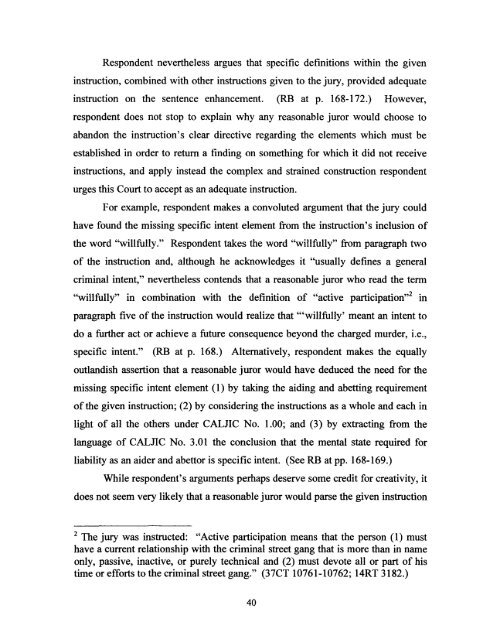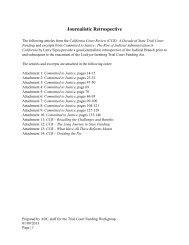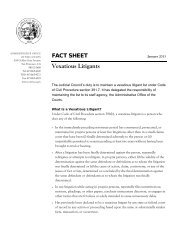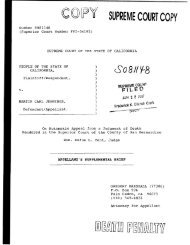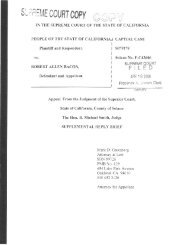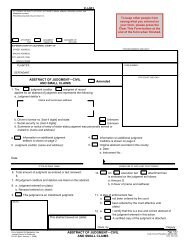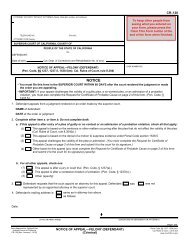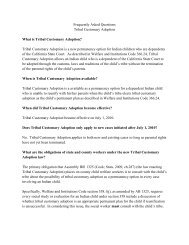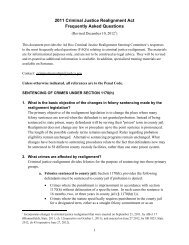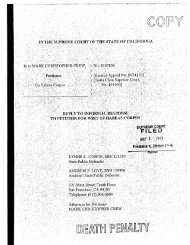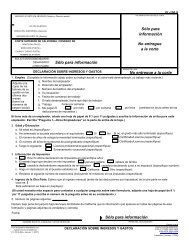Appellant, William Satele, Reply Brief - California Courts - State of ...
Appellant, William Satele, Reply Brief - California Courts - State of ...
Appellant, William Satele, Reply Brief - California Courts - State of ...
Create successful ePaper yourself
Turn your PDF publications into a flip-book with our unique Google optimized e-Paper software.
Respondent nevertheless argues that specific defmitions within the given<br />
instruction, combined with other instructions given to the jury, provided adequate<br />
instruction on the sentence enhancement. (RB at p. 168-172.) However,<br />
respondent does not stop to explain why any reasonable juror would choose to<br />
abandon the instruction's clear directive regarding the elements which must be<br />
established in order to return a finding on something for which it did not receive<br />
instructions, and apply instead the complex and strained construction respondent<br />
urges this Court to accept as an adequate instruction.<br />
For example, respondent makes a convoluted argument that the jury could<br />
have found the missing specific intent element from the instruction's inclusion <strong>of</strong><br />
the word ''willfully.'' Respondent takes the word ''willfully'' from paragraph two<br />
<strong>of</strong> the instruction and, although he acknowledges it "usually defines a general<br />
criminal intent," nevertheless contends that a reasonable juror who read the term<br />
''willfully'' in combination with the definition <strong>of</strong> "active participation,,2 in<br />
paragraph five <strong>of</strong> the instruction would realize that "'willfully' meant an intent to<br />
do a further act or achieve a future consequence beyond the charged murder, Le.,<br />
specific intent." (RB at p. 168.) Alternatively, respondent makes the equally<br />
outlandish assertion that a reasonable juror would have deduced the need for the<br />
missing specific intent element (1) by taking the aiding and abetting requirement<br />
<strong>of</strong>the given instruction; (2) by considering the instructions as a whole and each in<br />
light <strong>of</strong> all the others under CALJIC No. 1.00; and (3) by extracting from the<br />
language <strong>of</strong> CALliC No. 3.01 the conclusion that the mental state required for<br />
liability as an aider and abettor is specific intent. (See RB at pp. 168-169.)<br />
While respondent's arguments perhaps deserve some credit for creativity, it<br />
does not seem very likely that a reasonable juror would parse the given instruction<br />
2 The jury was instructed: "Active participation means that the person (l) must<br />
have a current relationship with the criminal street gang that is more than in name<br />
only, passive, inactive, or purely technical and (2) must devote all or part <strong>of</strong> his<br />
time or efforts to the criminal street gang." (37CT 10761-10762; 14RT 3182.)<br />
40


